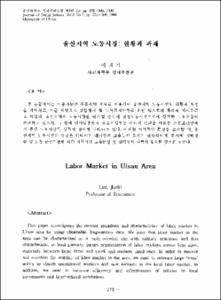연구개발비(R&D)와 미래의 경제적 효익
- Alternative Title
- Future Economic Benifits of Corporate R&D
- Abstract
- 우리나라의 연구개발비는 경상연구개발비와 비경상연구개발비로 구분하여 경상연구개발비는 비용처리하고 비경상연구개발비는 이연자산으로 회계처리하도록 하고 있다. 비경상연구개발비가 이연자산으로 회계처리 되려면 자산으로서 가져야 하는 미래의 경제적 효익이 있어야 할 것이며 이는 실증적으로 규명되어야 할 사안이다. 본 연구에서는 연구개발비가 미래의 경제적 효익이 있는지를 이익모델을 이용하여 실증적으로 검증하였다.
연구결과 실물자산과 광고비는 기존의 연구와 같이 당해연도의 이익에 영향을 미치나 연구개발비의 경우에는 대체로 과거의 연구개발비가 당해연도의 이익에 영향을 미치지 않는 것으로 나타났다. 이는 연구개발비가 미래의 경제적 효익이 없어 비용 처리하는 것이 타당하다고 해석할 수 있으나 자료의 신뢰도에 문제가 있을 수 있으므로 결론을 내리기 위해서는 앞으로 좀 더 많은 유사한 연구가 반복되어야 할 것이다.
R&D Expenditures in Korea are classified into two types: usual R&D expenditures and unusual R&D expenditures. Usual R&D expenditures are expensed in the year of incurrence, while unusual expenditures are recoreded as a defered charge and amortized equally over five years. Unusual R&D expenditures should have future economic benefits if it is classified as an asset. This study investigated whether R&D expenditures had future economic benefits using the earning model.
The results of the study revealed that real assets and advertising expenditures in the model had coefficients that were statistically as other studies showed. On the other hand, the coefficients of R&D expenditures were largely not statistically significant. The results can be interpreted that R&D expenditures do not have future economic benefits so they should be expensed in the year of incurrence. However, this may result from unstability of the R&D dat, so the investigation should be repeatd in the future to make a conclusion on this issue.
R&D Expenditures in Korea are classified into two types: usual R&D expenditures and unusual R&D expenditures. Usual R&D expenditures are expensed in the year of incurrence, while unusual expenditures are recoreded as a defered charge and amortized equally over five years. Unusual R&D expenditures should have future economic benefits if it is classified as an asset. This study investigated whether R&D expenditures had future economic benefits using the earning model.
The results of the study revealed that real assets and advertising expenditures in the model had coefficients that were statistically as other studies showed. On the other hand, the coefficients of R&D expenditures were largely not statistically significant. The results can be interpreted that R&D expenditures do not have future economic benefits so they should be expensed in the year of incurrence. However, this may result from unstability of the R&D dat, so the investigation should be repeatd in the future to make a conclusion on this issue.
- Issued Date
- 1997
- Type
- Research Laboratory
- Alternative Author(s)
- Kim, Jeong-Youn
- Publisher
- 경영학연구논문집
- Language
- kor
- Rights
- 울산대학교 저작물은 저작권에 의해 보호받습니다.
- Citation Volume
- 4
- Citation Number
- 2
- Citation Start Page
- 137
- Citation End Page
- 155
- Appears in Collections:
- Research Laboratory > Journal of management
- 파일 목록
-
-
Download
 000002024529.pdf
기타 데이터 / 1.02 MB / Adobe PDF
000002024529.pdf
기타 데이터 / 1.02 MB / Adobe PDF
-
Items in Repository are protected by copyright, with all rights reserved, unless otherwise indicated.